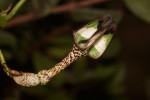6874.000 Ceropegia
Bruyns, P.V., Klak, C. & Hanáček, P. (2017) A revised, phylogenetically-based concept of Ceropegia (Apocynaceae) South African Journal of Botany 112 399-436
Dyer, R.A. (1980) Asclepiadaceae: Brachystelma, Ceropegia and Riocreuxia Flora of Southern Africa 27(4) 1 - 88
Goyder, D.J., Gilbert, M.G. & Venter, H.J.T. (2020) Apocynaceae (Part 2) Flora Zambesiaca 7(2)
Description of the genus
Perennial herbs; rootstock a cluster of fusiform roots, a globose to disciform tuber or series of tubers or, rarely a rhizome or, in species with succulent stems, often with fibrous roots only; latex clear, rarely slightly cloudy in succulent stemmed species; indumentum of simple hairs. Stems erect, twining or trailing, herbaceous or succulent, sometimes slightly woody at base in more robust twining species. Leaves opposite, petiolate or sessile, sometimes reduced and scale like. Inflorescences extra-axillary, sometimes apparently terminal, pedunculate or sessile, mostly umbel-like cymes, less often raceme-like or paniculate. Sepals free or almost so, filiform to lanceolate, acute. Corolla varying from divided almost to the base to forming a well-developed tube longer than the free parts of the corolla lobes, often with the base enlarged into a basal chamber; lobes varying from strongly reflexed to incurved and joined at their tips to form a cage, tips sometimes enlarged to form a parasol-like structure or extended into terminal beak or column, glabrous or hairy, hairs sometimes clavate and versatile. Gynostegial corona 2-seriate; outer series mostly two-lobed, sometimes joining laterally to form continuous cup, sometimes reduced to small teeth at bases of inner lobes or virtually absent; inner series more or less linear, varying from about as long as anthers and horizontal to erect, often adhering to form central column, or reduced to small teeth on inside of cupular outer corona. Anthers reaching margin of gynostegial cap; pollinia ovoid to more or less D-shaped, attached basally to the small translater arms and with well-developed germination crests on inner margins. Follicles usually paired, rarely solitary, parallel to widely divergent, narrowly to broadly fusiform, hairless. Derivation of name: from Greek: keros, meaning wax and pege, a stream of fountains, referring to the waxy nature of some of the flowers. Comment: We follow the concepts of Flora Zambesiaca where it has been accepted that Brachystelma should be sunk under Ceropegia but to keep the stapeliad genera as separate and accepted. Analyses have shown the stapeliads to form a very well defined monophyletic group nested within Ceropegia. However, formal inclusion of this group within Ceropegia as proposed by Bruyns et al. (2017) is not accepted. The stapeliads offer a very good example of a situation that makes a strong case for the acceptance of paraphyletic grouping as the alternatives of either following Bruyns et al. (2017) and lumping everything into the one genus, or of dividing up Ceropegia into what would have to be a very long series of totally new genera, are both impracticable as they would cause a major disruption in the connectivity of data within the group through the introduction of very many unfamiliar and thus uninformative names and thus serve very little useful purpose. The indications so far are that it is likely that such changes will not be accepted by the user community. Worldwide: C. 380 species in Arabia, Africa, Madagascar, Indian Peninsula and China. Caprivi: 9 taxa. Insects associated with this genus:
|
 |
Links to taxa: View: living plant images - herbarium specimen images - all images for this genus
| Species | Content | |
| arenarioides M.G. Gilbert | Description, Image | |
| bonafouxii K. Schum. | Image | |
| lugardiae N.E. Br. subsp. lugardiae [LR-lc] | Description, Image | |
| meyeri Decne. | Description, Image | |
| multiflora Baker subsp. tentacula (N.E. Br.) H. Huber [LR-lc] | Description, Image | |
| nilotica Kotschy [LR-lc] | Description, Image | |
| paricyma N.E. Br. | ||
| purpurascens K. Schum. [VU] | Description, Image | |
| stenantha K. Schum. [VU] | Description, Image |
Other sources of information about Ceropegia:
Our websites:
Flora of Botswana: CeropegiaFlora of Burundi: Ceropegia
Flora of the DRC: Ceropegia
Flora of Malawi: Ceropegia
Flora of Mozambique: Ceropegia
Flora of Rwanda: Ceropegia
Flora of Zambia: Ceropegia
Flora of Zambia: cultivated Ceropegia
Flora of Zimbabwe: Ceropegia
Flora of Zimbabwe: cultivated Ceropegia
External websites:
African Plants: A Photo Guide (Senckenberg): CeropegiaBHL (Biodiversity Heritage Library): Ceropegia
EOL (Encyclopedia of Life): Ceropegia
GBIF (Global Biodiversity Information Facility): Ceropegia
Google: Web - Images - Scholar
iNaturalist: Ceropegia
IPNI (International Plant Names Index): Ceropegia
JSTOR Plant Science: Ceropegia
Mansfeld World Database of Agricultural and Horticultural Crops: Ceropegia
Plants of the World Online: Ceropegia
Tropicos: Ceropegia
Wikipedia: Ceropegia